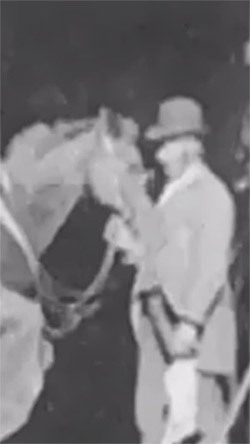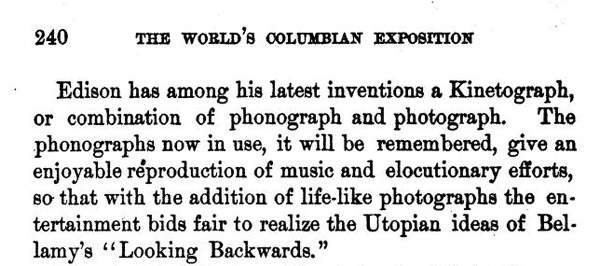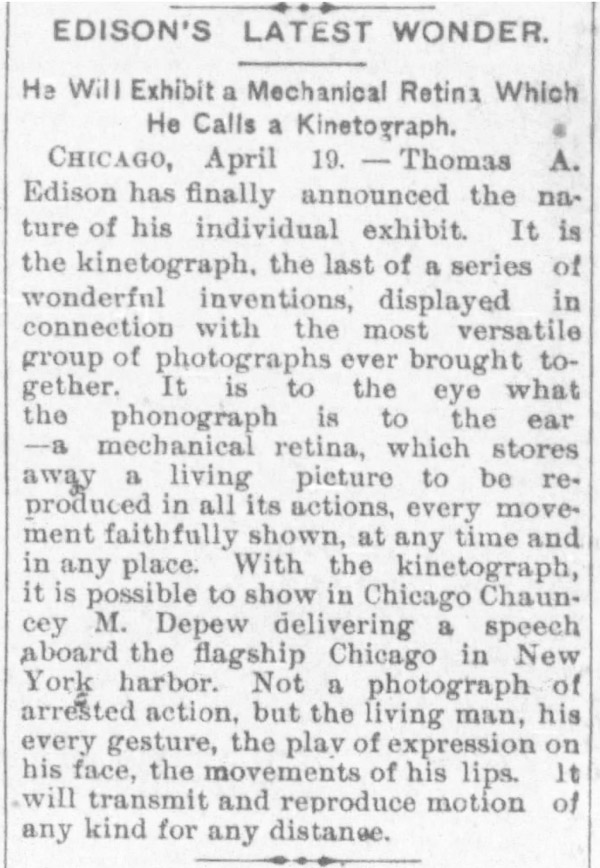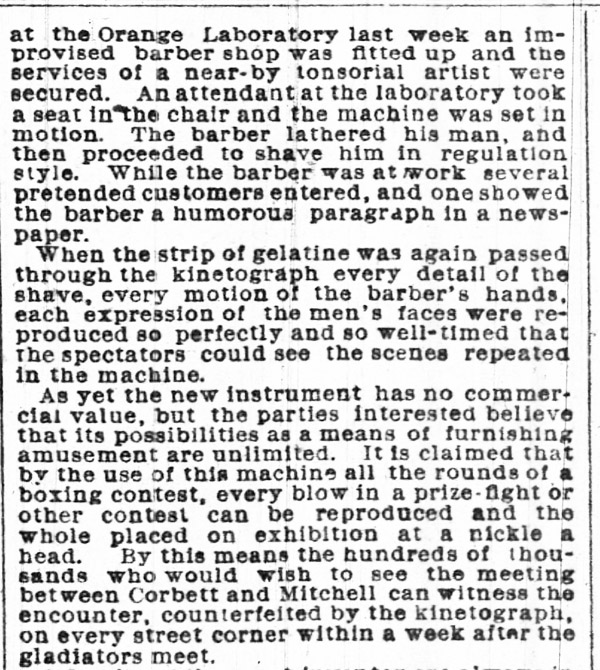The World's Columbian Exposition of 1893 and the Kinetograph
References, Annotations and End Notes
The Kinetograph References, Annotations and End Notes
The following are contemporary newspaper clippings related to the kinetograph's history, description, demonstration, and intended destination of Chicago and the World's Columbian Exhibition as Edison's "Individual Exhibit of the Great Inventor." This scrapbook and notes relate back to Phonographia's "The World's Columbian Exhibition of 1893 and the Kinetograph."
Clippings from newspapers written by "fair visitors" about their trip to the World's Columbian Exhibition of 1893 can be seen in Phonographia's "Fairground Fiction" in Newspapers.
The Kinetograph's First Public DemonstrationScientific American, May 20, 1893 - First Public Exhibition of Edison's Kinetograph,

Charles Musser summarized the audience viewing the kinetoscope film after George M. Hopkins finished his lecture at the premier of Edison's new motion picture system, the kinetoscope and kinetograph camera on May 9, 1893 as follows:
"When the lecture concluded, at least two twenty-second films were shown: BLACKSMITHING SCENE and HORSE SHOEING. Four hundred people in attendance lined up in front of Edison's peep-hole kinetoscope and one by one looked in the viewer and saw one of these two films."

Musser's footnote for this is the following: "First Public Exhibition of Edison's Kinetograph," Scientific American 20 May 1893: 310; "Department of Physics," Brooklyn Daily Eagle 10 May 1893:
9. In the original version I only mentioned BLACKSMITHING SCENE, but in the meantime I have established two films were shown at the Brooklyn Institute of Arts and Science on 9 May 1893. "Charles Musser's Chapter "Rethinking Early Cinema: Cinema of Attractions and Narrativity" in The Cinema of Attractions Reloaded Edited by Wanda Strauven Copyright: 2006 Publisher: Amsterdam University Press
The Encyclopedia of Early Cinema edited by Richard Abel, Routledge Press 2005 also notes (p. 358) that at the first public exhibition of the kinetograph in Brooklyn on May 9, 1893 "Two films were shown: Blacksmithing Scene and Horse Shoeing."
Chicago Tribune, May 13, 1891
Chicago Tribune, May 13, 1891
Chicago Tribune, May 28, 1891
Chicago Tribune, May 28, 1891
The Pall Mall Gazette, London, May 29, 1891
The Pall Mall Gazette, London, May 29, 1891, p. 6
Wilkes-Barre Times Leader The Evening News, May 28, 1891
Wilkes-Barre Times Leader The Evening News, May 28, 1891 p. 1
Chicago Tribune, October 7, 1891
Chicago Tribune, October 7, 1891 p. 9
The Kinetograph - A New Industry Heralded, The Phonogram, October 1892

The Historical World's Columbian Exposition and Chicago Guide, Pacific Publishing Co., 1892
The Indianapolis News, April 27, 1893 - "The Kinetograph To Be the Individual Exhibit of the Great Inventor At the World's Fair"


The Indianapolis News, April 27, 1893 p. 5
"The kinetograph is to the eye what the phonograph is to the ear -- a mechanical retina."

Madison Chronicle, Madison, Nebraska April 27, 1893 p. 7
The Lindsborg News, Lindsborg, Kansas April 28, 1893

The Lindsborg News, Lindsborg, Kansas April 28, 1893 p. 2
The Alton Weekly Telegraph, Alton, Illinois, July 13, 1893 titled "The Kinetograph and Kinetoscope" - Kinetograph almost ready to be put upon the market but still at Edison's lab.

The Alton Weekly Telegraph, Alton, Illinois, July 13, 1893 p. 9
Ottawa Daily Citizen, March 10, 1893

The Champion, Norton, Kansas, April 27, 1893
The Champion, Norton, Kansas, April 27, 1893
The Evening World, New York, New York, May 28, 1891
The Evening World, New York, New York, May 28, 1891, p. 1
The Tennessean, Nashville, June 20, 1891
The Tennessean, Nashville, June 20, 1891, p. 4
Vermont Watchman and State Journal, Montpelier, VT, July 1, 1891
Vermont Watchman and State Journal, Montpelier, VT, July 1, 1891, p. 3
Aurora News-Register, Aurora, NE July 18, 1891
Aurora News-Register, Aurora, NE July 18, 1891

St. Louis Globe-Democrat, December 10, 1893 p. 8

Person County Courier, Roxboro, NC, November 23, 1893
The following was written by White and Igleheart about Edison's Phonograph and Kinetograph exhibits at the World's Columbian Exposition in 1893 in their book The World's Columbian Exposition, Chicago, 1893. It was published in 1893 at the end of the fair and included the final chapter "After the Fair is Over." One would expect that these authors would have corrected any pre-fair information that was incorrect and in this case about Edison's planned exhibit of what they described as the combination phonograph and stereopticon.
This paragraph from their book has been included as another example how Edison's displays at the fair were described including his "kinetograph" despite conclusions that can be made that it wasn't. The following error regarding the kinetograph at the fair would seem to be based on the same expectations and information that newspapers around the United States had prior to the fair and the subsequent lack of verification during the fair as to the accuracy of whether Edison's Kinetograph was actually ever at the fair.
The World's Columbian Exposition, Chicago, 1893. Trumbull White and Wm. Igleheart, published by J. S. Ziegler & Co., Chicago, IL, 1893. p. 326.
The Larned Eagle-Optic, Larned, KS, April 20, 1894 - "The business of the kinetograph is to take the pictures, and the function of the kinetoscope is to display them to the eye..."


The Larned Eagle-Optic, Larned, KS, April 20, 1894 p.1
"FAIRGROUND NEWS"
See 1893 Fairground News for examples of articles in periodicals, letters to newspapers and interviews about, or set in, World's Fairs and printed in newspapers.
\
The first public exhibition of the kinetograph included the lecture by Mr. George M. Hopkins who explained how the kinetograph worked. "This apparatus is the refinement of Plateau's phenakistoscope or the zootrope...In addition to Plateau's experiments, I might refer to the work accomplished by Muybridge and Anschuetz, who very successfully photographed animals in motion...But these instruments, having but twenty-five or thirty pictures for each subject...could not make the image appear like a continuous photograph of moving things. In Mr. Edison's machine far more perfect results are secured."
The first public exhibition of the kinetograph included the lecture by Mr. George M. Hopkins who explained how the kinetograph worked. "This apparatus is the refinement of Plateau's phenakistoscope or the zootrope...In addition to Plateau's experiments, I might refer to the work accomplished by Muybridge and Anschuetz, who very successfully photographed animals in motion...But these instruments, having but twenty-five or thirty pictures for each subject...could not make the image appear like a continuous photograph of moving things. In Mr. Edison's machine far more perfect results are secured."
Muybridge's Zoopraxographical Hall at the World's Columbian Exhibition
At the World's Columbian Exhibition on the Midway Plaisance and "directly to the east of the Streets of Cairo was the Zoopraxographical Hall. The building was considered by many film historians to be the first commercial movie theater.
Eadweard Muybridge, an English photographer who was born Edward James Muggeridge, used the hall to demonstrate his Zoopraxiscope. Muybridge invented the Zoopraxiscope in 1879 and used it at the many lectures he would give around the world. The Zoopraxiscope combined photography, the Magic Lantern (projected still images) and both the Zoetrope (spinning drums) and Phenakistiscope (spinning discs)." (Text and video courtesy of Friends of the White City)
Visit to see Compleat Eadweard Muybridge: Chronology 1893-1904 (including references to letters/communication with Edison)
Zoopraxographical Hall - Considered by many film historians to be the first commercial movie theater
From Stereoview card - Muybridge Display
Stereo view of the Zoopraxigraphical Hall at the World's Fair in Chicago. Shows the hall where Muybridge gave lectures and sold photographs.
Watch Muybridge's Zoopraxoscope - Setting Time in Motion Video
A Chocolate Films Production for Kingston Museum
Notes from the Exposition by J. C. Ruppenthal, Jr., CHICAGO, ILL, July 10, 1893
"A nickel will secure a hearing on the graphophone or the Edison phonograph. These are widely scattered and well patronized. The same coin dropped into the tachyscope will set it at work. A series of instantaneous photographs taken from living models are revolved so that successive movements follow one another in proper sequence. The result is that is appears as if the animals are going through different motions."
New Concessions Granted by the Exposition Authorities included installation of fifty tachyscopes on Midway Plaisance
Edison Barber Shop Film December 1893
On December 10, 1893, seven months after the Kinetograph was supposed to have debuted at the World's Columbian Exposition and two months after the fair had closed, the St. Louis Globe-Democrat published an article which announced that Edison's nickel-in-the-slot kinetograph would soon be put on the market. The article also stated that "The new instrument has no commercial value, but the parties interested believe that its possibilities as a means of furnishing amusement are unlimited." It was also stated that this kinetograph was not going to provide "sounds to the ear."
The St. Louis Globe-Democrat also described the making of a film the previous week (circa December 8, 1893) at the Orange Laboratory where " an improvised barber shop was fitted up and the services of a near-by tonsorial artists were secured." The kinegraph camera was used to film the barber, who "lathered his man, and then proceeded to shave him in regulation style. While the barber was at work several pretended customers entered, and one showed the barber a humorous paragraph in a newspaper." When the film was then played the details "were reproduced so perfectly and so well-time that the spectators could see the scenes repeated in the machine."Edison's personal testimonial to Ramsaye's "unrelenting effort at exact fact."
Ramsaye did extensive research regarding the history of the kinetograph and kinetoscope and interviewed many who were part of the film industry from its beginning. The frontis page of his book has a personal testimonial that Edison gave to Ramsaye's book when he wrote: "I have been in contact with the author's researches through his years of preparation and I am aware of an unrelenting effort at exact fact. A high degree of detailed accuracy has been attained."
Phonographia.com - World's Columbian Exhibition of 1893